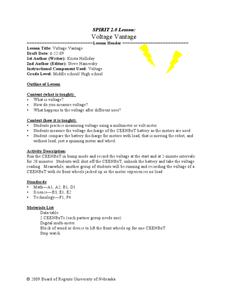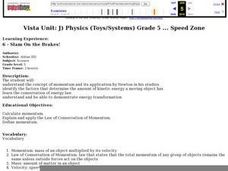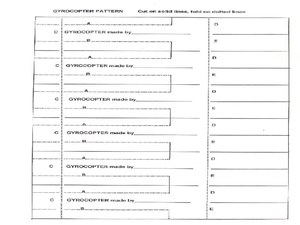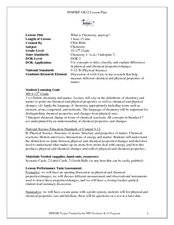Curated OER
Describe the Perfect Pathogen
Students develop a pathogen based upon their knowledge of pathogens and after presenting it to the class, they then suggest ways that the pathogen might be combated. Next they identify possible physical or behavioral changes in a...
Curated OER
Profess the Compress
Students determine the ground clearance of CEENBoTs by adding weights. In this physics lesson plan, students explore the compression and extension of different springs. They cite real world applications of Hooke's Law.
Virginia Department of Education
Work and Power
Assist your class with correctly calculating the values for force, work, and power as they determine the amount various activities require. They gather data and participate in a group discussion to compare results upon conclusion of the...
Curated OER
Opposites Attract
Pupils demonstrate the attraction of small pieces of paper to a charged plastic rod and conduct experiment with other objects to determine whether they can hold a charge. They then use online applets to apply their experiments to...
Curated OER
Don’t Sit Under the Apple Tree…You Might Become Famous
Students explore Newton's laws using CEENBoTs. In this physics lesson, students collect data and create tables and graphs. They calculate speed, acceleration and forces using mathematical formulas.
Curated OER
Discussion of Adaptation
Students discuss ways in which dinosaurs adapted to their environments. They apply the same logic to an analysis of human habitat, survival needs, and survival need fulfillment to explain how people have adapted to their environment.
Curated OER
Clay Atoms-Taming Our Fear Of The Invisible
Young scholars create atoms with clay by using different colors to represent the protons, neutrons and nucleus. In this creative lesson students use clay to learn about atoms and see how they apply to the periodic table.
Curated OER
Energy Efficiency: It really IS important!
Students compare the energy needed to produce new products versus recycling. In this physics lesson, students brainstorm ways to save energy. They create a presentation about the correlation between conserving energy and energy costs.
Curated OER
No Flaw With Newton’s 1st Law
Students explain what inertia is in their own words. In this physics lesson, students investigate how Newton's first law applies to their robot. They discuss real world examples of the 1st law.
Curated OER
The Wheels on the Bot Go Round and Round, Part I
Learners determine how speed is measured. In this physics lesson, students design an experiment to find out if the robot's drive wheel size affects its speed. They collect data and discuss results.
Curated OER
Wheels on the Bot Go Round and Round, Part II
Students hypothesize about the relationship between tire size of CEENBoT and ability to move a load. For this physics lesson, students design an experiment to test their hypothesis. They record results and formulate their conclusion.
Curated OER
Voltage Vantage
Students measure the voltage discharge of robots as the motors are used. In this physics lesson, students explain how to use a multimeter to measure voltage. They graph the voltage change over time and present their findings in class.
Curated OER
Robotic Muscles
Young scholars investigate how adding more pulleys affect the pulling power. For this physics lesson, students explain how pulleys work. They compare the work done by robots with and without pulleys.
Curated OER
Secondary Robot
Students identify the forces acting on a stationary/constant velocity robot. In this physics lesson, students draw a free body diagrams of the forces. They explain the difference between zero acceleration and zero net force.
Virginia Department of Education
Heat and Thermal Energy Transfer
How does radiation affect our daily lives? Answer that question and others with a lesson that discusses radiation and its use in thermal energy transfer through electromagnetic waves. Pupils investigate vaporization and evaporation while...
Science Matters
Energy and Winds
In the study of wind energy, scholars build a small windmill and observe how it transfers wind into mechanical energy. Learners will make connections to the previous lesson with concepts such as the creation of wind through convection.
Curated OER
Slam On the Brakes!
Fifth graders study the concept of momentum and its application by Newton in his studies. They view a demonstration and complete an experiment with toy cars on a racetrack that shows them the properties of momentum and how velocity and...
Curated OER
SMASH Skill Development: Badminton
Students perform the SMASH technique and overhand motion. For this SMASH lesson, students practice hitting targets using racquets and the overhand motion. Students also complete a target smash drill using hula hoops.
Curated OER
Greenhouse Gases: The Chemistry Behind the Culprits
Ninth graders investigate the effect of different gases in the atmosphere. In this chemistry lesson plan, 9th graders explain how these gases contribute to global warming. They suggest possible solutions to this growing problem.
Curated OER
Gyrocopters-Producing Rotary Motion
Students demonstrate rotary motion by practicing with gyrocopters. In this physics lesson students work in groups to construct a gyrocopter and explore how physics effect it torque and inertia.
Curated OER
What Is Chemistry, Anyway?
Students differentiate physical and chemical change. For this chemistry lesson, students list examples of those changes. They apply what they learned in a Jeopardy style team game.
Curated OER
Newton’s Laws of Motion
Eighth graders explore the three laws of motion. For this physics lesson, 8th graders observe teacher demonstration and explain what happened in terms of Newton's Laws. They complete worksheet at the end of the lesson.
Curated OER
Forces Cause Change
Third graders will gain recognition that physical relationships affect each other and that change occurs when one object acts upon another.The teacher will recognize ways in which technology can be used to enhance the understanding of...
Curated OER
Force Counterforce
Students hypothesize what forces affect the motion of a falling body. For this physical science lesson, students create diagrams and illustrations to support their hypothesis. They perform the experiment and record observations.

























